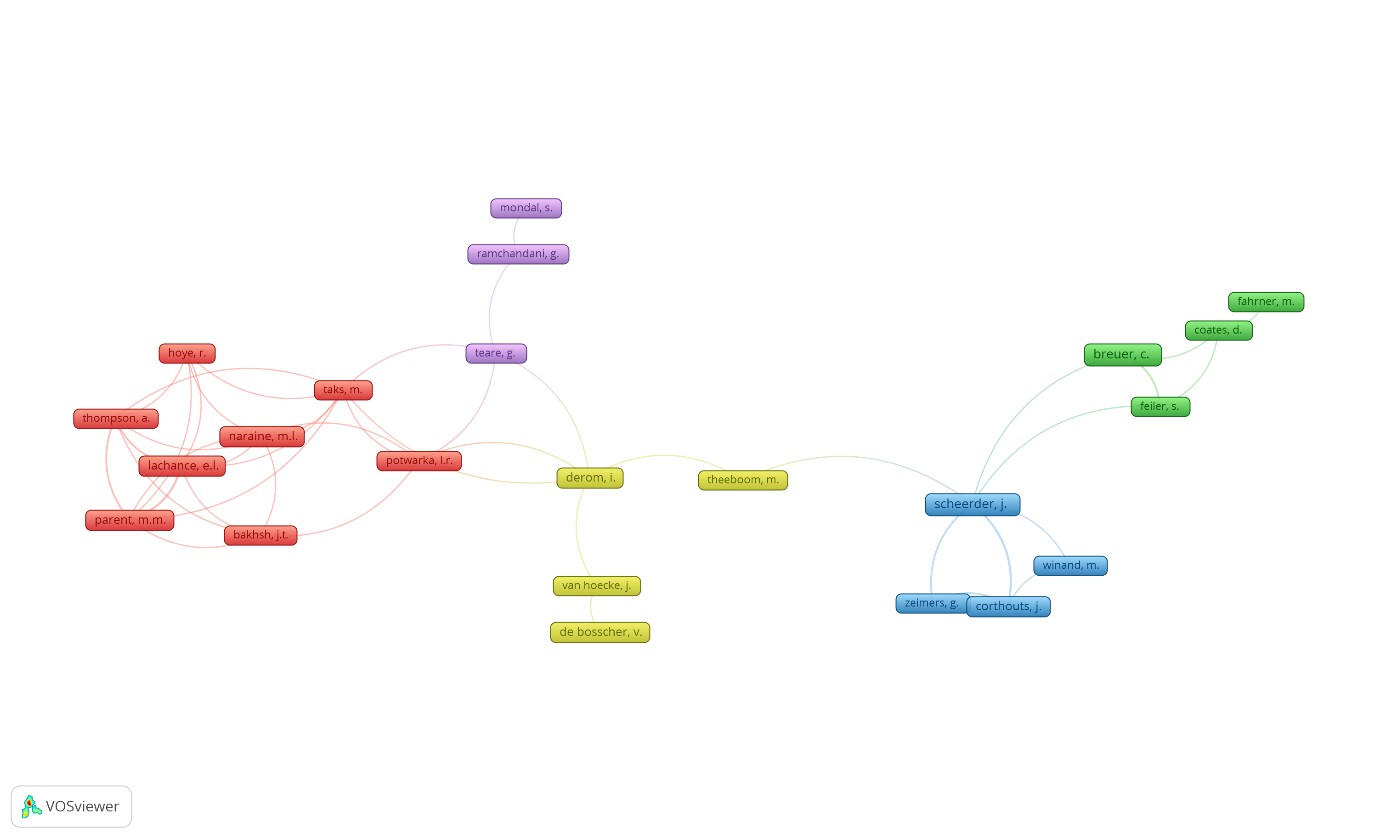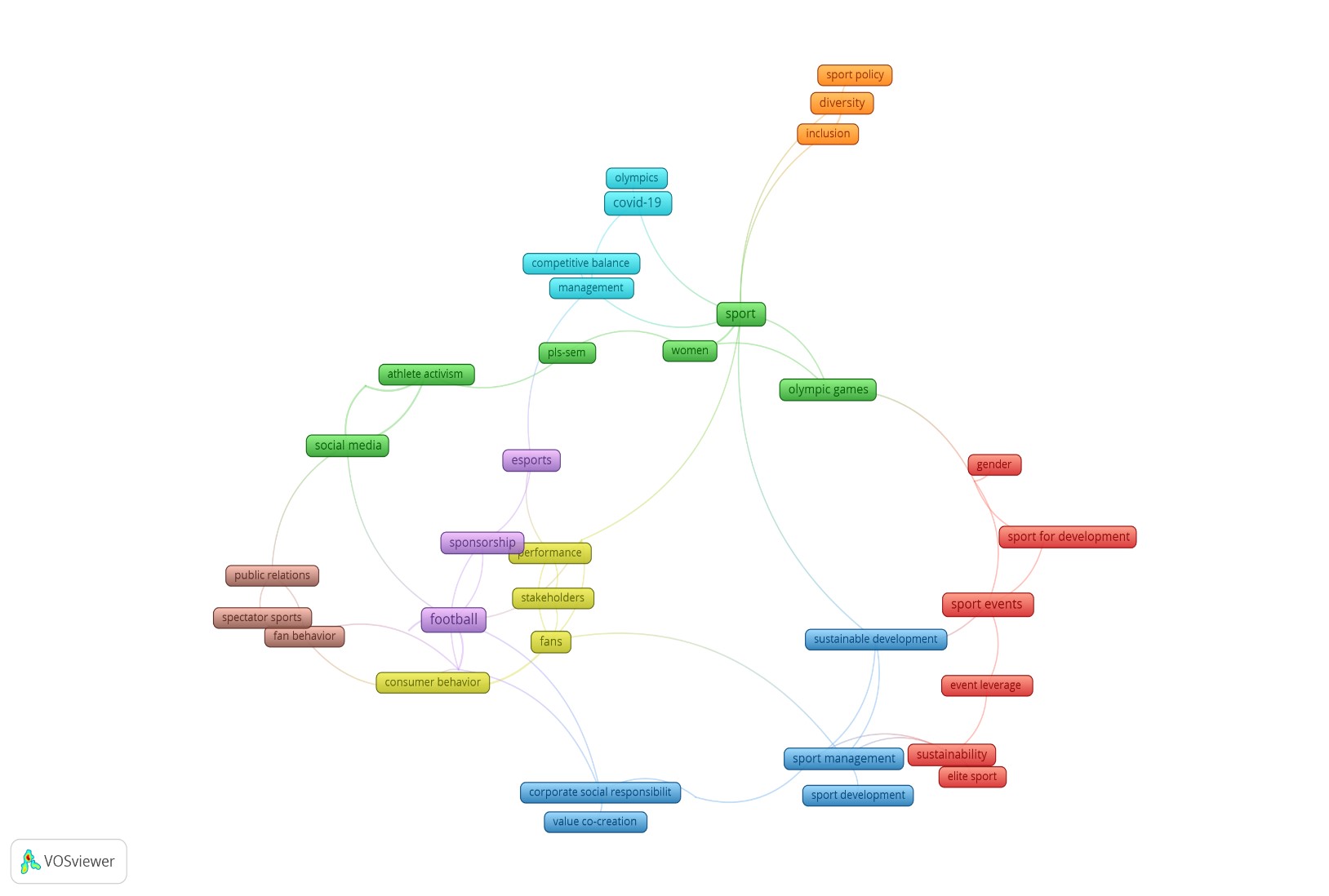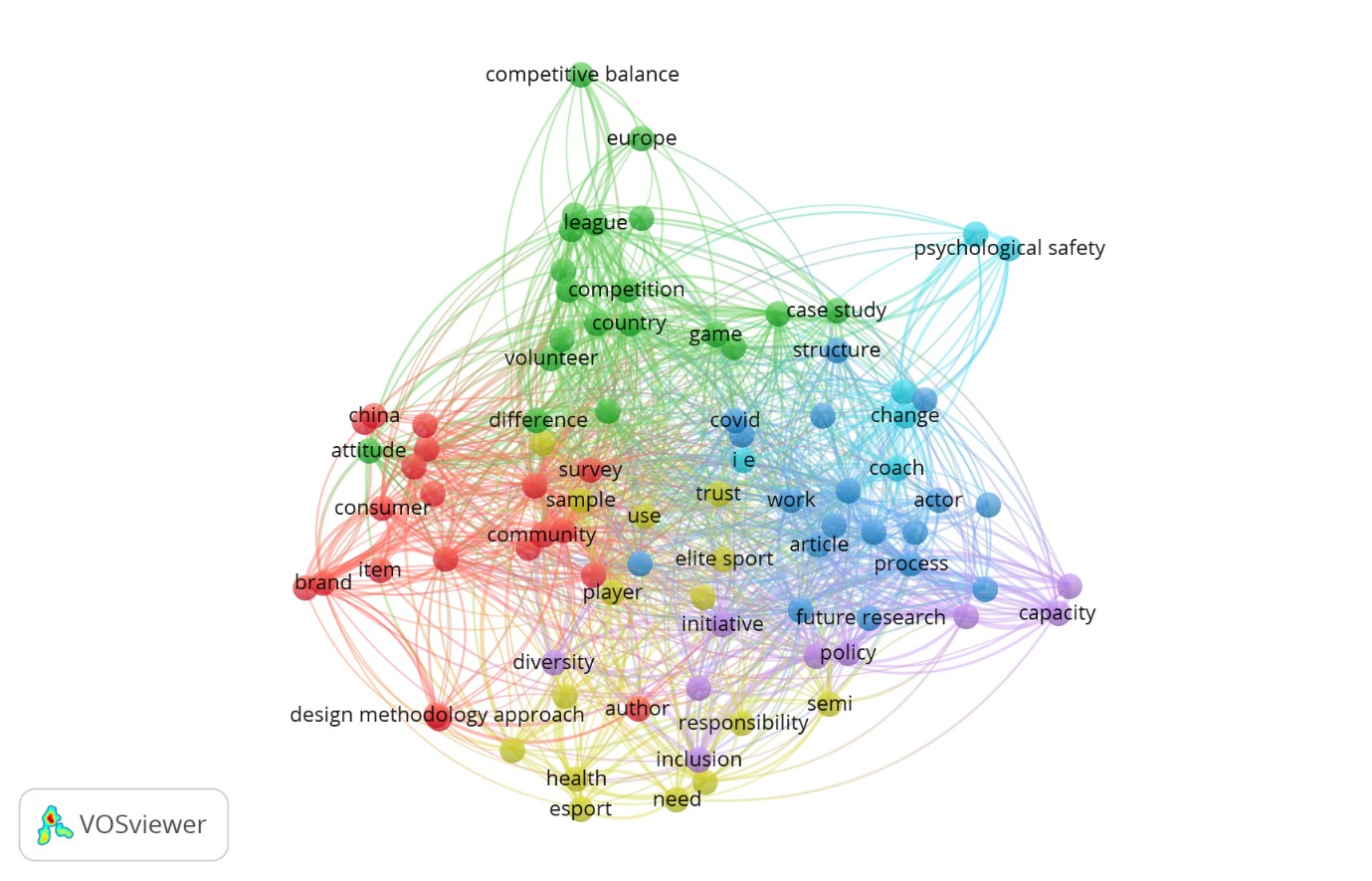Research Article
State of Sport Management Research in the first half of 2023 (January - July)

This introductory article of the Sport Management Digest (SMD) provides a bibliometric review of the research published in the 10-sport management journals in the first half of 2023 – from January to July. The eight thematic sections that follow cover in sufficient detail research pertinent to different aspects of sport management. As promised, the current issue includes a theoretical section, but due to technical reasons we were unable to include the review of sport communication research, which will be made available as soon as possible. The role of bibliometric analysis, as a computer-assisted quantitative review methodology, is to identify core research or authors, as well as their relationship. It provides valuable relational information on the topic, which helps significantly enhance our understanding of the overall intellectual structure of the sport management discipline.
Following the established format of the introductory article, the present overview of research in the field of sport management focuses on three interrelated areas including a bibliometric analysis, theoretical and practical appeal of research, as measured by the funding received by different studies, and the democratization of knowledge, as exemplified by the number of studies published under the Open Access (OA) regime. In the first half of 2023, the ten sport management journals combined published 43 issues with 297 articles. This is a significant number of outputs compared to the previous six months. A diverse group of researchers contributed to the field including established and upcoming scholars as well as PhD students. Table 1 shows the ten journals and the number of articles per journal including the Open Access (OA) ones. The first half of 2023 saw 297 published articles which is 93 more than the 204 produced in the second half of 2022, but the percentage of OA articles was less - 12% (47), compared to 19% (53). Xiaoyan Xing in this issue offers a very details analysis of the geography of sport management publications.
As discussed in previous issues, the OA publication policy reflects an important imperative for the democratisation of knowledge, which suggests that all publicly and privately funded research ought to be made freely available for users. The challenges of the OA policy have been addressed in earlier issues of the SMD including its prohibitive cost for many researchers and institutions. Nonetheless, it is important to keep stressing this issue as it plays a critical role in shaping the knowledge in the field and its utilization. Readers can check out the OA policy of their targeted journal by using the ‘Journal checker tool’ https://journalcheckertool.org/. Advances in digital technology and publishing have made it possible for journals to change their publication policy, particularly those published by Taylor & Francis (5 of the journals in the table). Editors and authors have now been instructed that there is no longer a cap on articles word count, which is typically between 8,000-10,000 words. This means that authors could use the greater word allowance to expand on different sections of their papers including the use of more illustrations.
Table 1. Total number of articles and Open Access ones published in 10 sport management journals in the first half of 2023 (January - July)
| Journal | Founded |
Publication frequency/ year |
Impact factor 2021 |
Articles No |
Open Access No/% |
|---|---|---|---|---|---|
|
Journal of Sport Management https://journals.humankinetics.com/view/journals/jsm/jsm-overview.xml |
1987 |
5 |
3.69 |
21 |
2/0 |
|
Sport Management Review |
1998 |
5 |
6.57 |
30 |
2/0 |
|
International Journal of Sports Marketing and Sponsorship https://www.emerald.com/insight/publication/issn/1464-6668 |
1999 |
4 |
2.93 |
32 |
4/0 |
|
European Sport Management Quarterly |
2001 |
5 |
4.00 |
51 |
10/0 |
|
International Journal of Sport Finance |
2006 |
4 |
0.94 |
10 |
0/0 |
|
International Journal of Sport Communications https://journals.humankinetics.com/view/journals/ijsc/ijsc-overview.xml |
2008 |
4 |
N/A |
41 |
4/10 |
|
International Journal of Sport Policy and Politics |
2009 |
4 |
0.69 |
23 |
10/4 |
|
Journal of Sports Economics |
2011 |
6 |
2.22 |
26 |
5/23 |
|
Communication and Sport |
2013 |
6 |
3.17 |
32 |
6/0 |
|
Journal of Global Sport Management |
2016 |
4 |
N/A |
31 |
4/0 |
The 10 journals under review continued publishing special issues, which are designed to address important themes as well to break new grounds in the field. Sport management journals’ special issues have a positive impact on developing the field (Scelles, 2021). Three journals have published special issues addressing environmental matters in sport (ESMQ), diversity, equity and inclusion (IJSMS), and a critical examination of sport communication scholarship (IJSC). Individually and collectively, these special issues make a significant contribution to advancing our knowledge and the field of sport management in general. Table 2 shows the journals, special issues and guess editors.
Table 2. Special issues published by selected sport management journals (January-July 2023)
| Journal | Special Issue Topic | Editors |
|---|---|---|
|
European Sport Management Quarterly, 2023, 23(1) |
Environmental matters in sport: sustainable research in the academy |
Tim Breitbarth, Brian P. McCullough, Andrea Collins, Anna Gerke & David M. Herold |
|
International Journal of Sport Marketing & Sponsorship, 2023, 24 (1)
|
Diversity, Equity and Inclusion in Sport Marketing |
Antonio Williams, Natasha Brison, Ann Pegoraro |
|
International Journal of Sport Communications 2023 |
Social Media and Sport Communication: Critiquing the Scholarship |
Gashaw Abeza and Jimmy Sanderson |
Sport management research continues to asserts its conceptual and practical appeal to policy makers, practitioners and various public and private bodies as evidenced by the funding provided to different research projects. The funding picture of current research is by no means complete due to lack of information about the external funding behind the research, but it does allow to note the geography and institutional support of sport management scholarly activities. A number of public and private agencies supported research including the Australian Research Council, Ministry of Education, Gulf Research Program, Japan Society for the Promotion of Science, National Research Foundation of Korea, Social Sciences and SSHRC. Scholars from the following countries including United States, Canada, Australia, United Kingdom, Germany, Japan, Poland, and South Korea were successful in attracting funding support. A proxy measure of the relationship between external funding of sport management research and its theoretical and practical appeal is the increased impact factor of most SM journals in the sample including citations as a powerful measure of establishing the impact of journals on the research field (see Lis’ 2020 analysis).
The bibliometric analysis was conducted using the two major data bases including the Web of Science and Scopus. As with previous issues, science mapping and visualization was produced with the help of the VOSviewer software (van Eck & Waltman, 2020). The aim was to examine the strength of the links between sport management research by looking into the co-authorship links (i.e., the number of publications two researchers have co-authored), co-occurrence links (i.e., the number of publications in which two terms occur together), and the bibliographic coupling links (i.e., the number of cited references two publications have in common). The strength of the link is represented by a positive numerical value where the higher the value the stronger the link. The results are visualised in three figures. It ought to be noted though that due to the limited time subject to analysis (6 months), the co-authorship and co-occurrence links reported cannot be representative of the sport management field, rather they ought to be viewed as a snapshot.
Figure 1 below depicts the co-authorship links where two authors had worked together on a publication. Eighty-four authors who published in the ten journals, met the threshold of working together on two documents, and the different colours in figure 1 help see those collaborations.

Figure 1. Co-authorship network visualization across ten sport management journals in 2023 (January – July)
The co-occurrence links, representing the number of publications in which two terms occur together can be seen in Figure 2. Out of 1118 key words, 45 met the threshold of occurring more than 10 times. The size of the word indicates its weight. Figure 2 also helps to see the distance between two words where the higher the distance the lesser the connectedness. For example, the words ‘Olympic Games’, ‘athletes activism’, ‘social media’ were both interrelated and dominant in the research. They were complemented by ‘football’, ‘esports’ and ‘sponsorship’, which were also closely related to each other. A similar cluster of interrelated key words appears around ‘Covid19’, ‘computers’ and ‘management’.
The power of the different types of networks and the author co-citation (ACC) analysis lies in their ability to reveal the intellectual structure of the sport management discipline.
Figure 2. Key words co-occurrence network visualization in ten sport management journals in 2023 (January - July)

Figure 3. Full bibliographic coupling of the number of cited references two publications have in common.
Figure 3 represents the full bibliographic coupling where out of 6059 citations 146 met the threshold of occurring at least 10 times.

Admittedly, the SMD does not claim to provide a comprehensive analysis of sport management research globally as some studies do not get published in the selected 10 journals included in this review. We do hope, however, that the Sport Management Digest offers valuable guide to scholars, practitioners and students of sport. The high-level summaries included in this issue can serve as an entry point for understanding the intellectual structure of the discipline, the individuals and centres responsible for producing the studies as well as the topical issues discussed. It is hoped that it will help in stimulating debates and in informing decisions about research projects and teaching strategies.
Happy reading of the Sport Management Digest!
References
Lis, A. (2020). Sport management: Bibliometric study of key sources titles in the research field. Journal of Physical Education and Sport, 20 (4), 2423-2430.
Scelles, N. (2021). Impact of the special issues in sport management and sociology journals, Managing Sport and Leisure, DOI: 10.1080/23750472.2021.2008267
Van Eck, N. J., & Waltman, L. (2020). Software survey: VOSviewer, a computer program for bibliometric mapping. Scientometrics, 84(2), 523-538. https://doi.org/10.1007/s11192-009-0146-3
